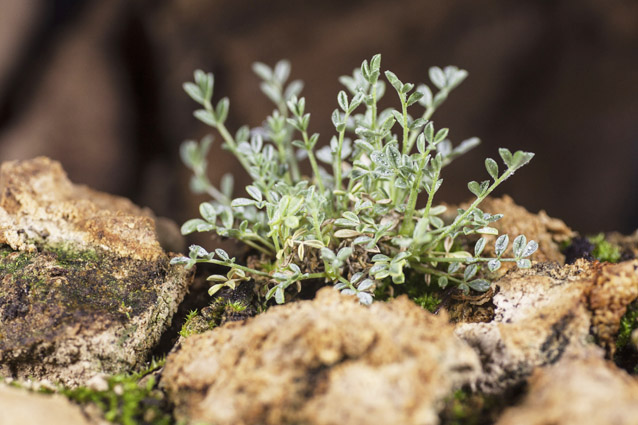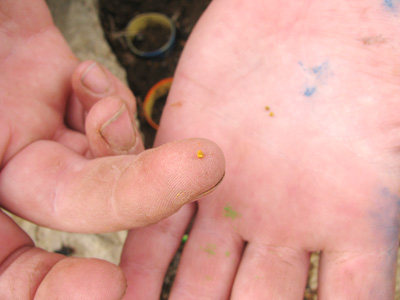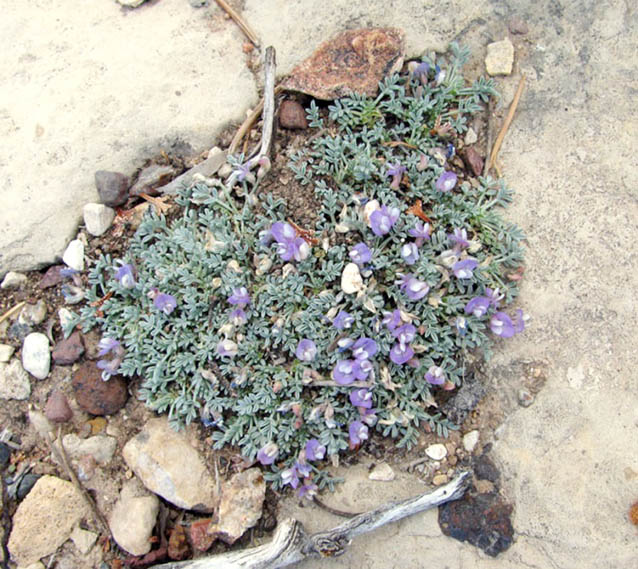
NPS
Sentry milk-vetch (Astragalus cremnophylax Barneby var. cremnophylax Barneby) was listed as an endangered species on December 5, 1990 (55 FR 50184-50187) pursuant to the Endangered Species Act of 1973, as amended (16 U.S.C. 1531 et seq.). In 2006, when the sentry milk-vetch recovery plan was published (U.S. Fish and Wildlife Service 2006), the plant was known to be found at only three locations on the South Rim. Since that time, additional populations of sentry milk-vetch have been discovered on the South and North Rims. Currently there are five wild populations on the North Rim, four wild populations on the South Rim, and three introduced populations on the South Rim.
A summary of the 2016 field season accomplishments is presented here.
Maricopa Point Annual Monitoring. Maricopa Point was monitored by the Grand Canyon National Park vegetation program staff in May. A total of 1150 SMV were recorded, up from 935 in 2015. Combined with reintroduced plants, this brings the total population of sentry milk-vetch plants at Maricopa Point to 1,524, with all but 146 of the wild plants and 5 of the reintroduced plants outside the transect boundaries tagged to facilitate long-term monitoring.

NPS
Seed and Cutting Collection and Propagation. A total of 1,087 seeds were collected from three wild sites on the South Rim. Of these, 691 seeds were propagated with a 75% success rate. All seed from the Shoshone wild population was put into storage. No seed were collected from reintroduced or North Rim populations in 2016. A total of 284 cuttings were collected from South Rim sites; all were propagated with only a 13% success rate. Staff continue experimenting with cutting propagation, with the most successful mix being two parts perlite and one park coconut husk.
Site Mapping and Census. For the past two years, vegetation and GIS staff have completed detailed GIS mapping of all known sentry milk-vetch sites. The mapping is to 24 cm accuracy and is completed in conjunction with a complete census. The final mapping will be complete by November 2016. We have documented 16,705 plants in the park, with 9,103 on the South Rim and 7,602 on the North Rim. Of these, four populations have over 1,000 plants.
Supplemental Plantings at Grandview, Maricopa, and Busco Points. In 2016, staff continued to plant, water, and maintain each of the South Rim reintroduction sites. There are currently 121 living plants at Grandview (45% survival), 603 plants at Busco Point (79% survival), and 215 plants alive at the Maricopa reintroduction sites (70% survival). Crews watered the new plantings at all sites 4-5 times a week, and the older plantings 2-3 times a week, and completed exotic plant removal and other site maintenance throughout the season.
New Propagation Protocols. Staff continued to refine the propagation protocols, including the use of mist lines for more frequent and standardized water delivery, and grow lamps to encourage more compact growth forms. A new soil mix was used, containing more native soil relative to other soil components to increase likelihood of inoculation and decrease outplanting stress. The current mix is composted native mulch, native soil, sand, perlite, vermiculite and coconut husk. Fewer plants need to be propagated in the next few years, with a goal of getting each of the re-introduction sites to over 1000 plants but not doing any additional planting beyond that because of the overall success of the wild populations.

NPS
References
U.S. Fish and Wildlife Service. 2006. Sentry Milk-vetch (Astragalus cremnophylax Barneby var. cremnophylax Barneby) Recovery Plan. U.S. Fish and Wildlife Service, Albuquerque, New Mexico.
Prepared by Jean Palumbo (SCPN) and Lori Makarick (GRCA), 2016.
Part of a series of articles titled Recovering the Endangered Sentry Milk-Vetch in Grand Canyon National Park.
Last updated: October 25, 2016
